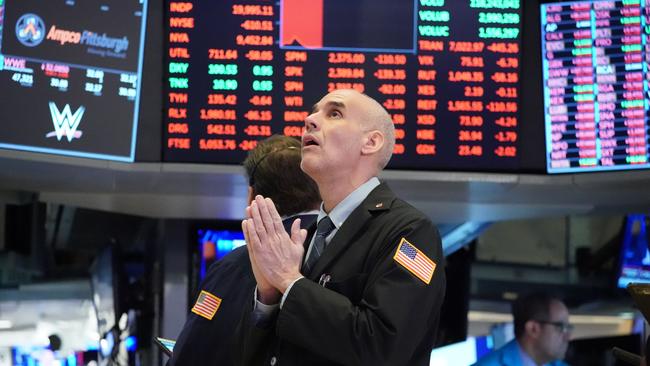How chaos took surprising turn
One year on from the day global sharemarkets fell into bear territory, investors could be forgiven for feeling some deja vu.

It was only a year ago that the world was starting to come to grips with the coronavirus pandemic and the US sharemarket entered its fastest bear market in history, amid expectations that coronavirus lockdowns would push the world into a deep recession and possibly even a depression.
Tuesday marks the 12-month anniversary of the day that global sharemarkets fell more than 7 per cent in a single session, taking them to the cusp of “bear markets” – defined as falls of at least 20 per cent from highs – after passing the 10 per cent “correction” markers in just over a week.
Of course the reality turned out quite differently to what most investors expected at the time, as central banks and governments unleashed an unprecedented degree of monetary and fiscal policy stimulus, the lethality and spread of the virus wasn’t as bad as expected, China bounced back strongly and the development of numerous highly-effective vaccines helped investors look forward to a recovery from what was in many cases the sharpest economic recession since WWII.
“Twelve months ago, corporate Australia was plunging headlong into the deep abyss of an incipient global pandemic,” said JPMorgan Australia head of research, Jason Steed.
“Most companies reacted by withdrawing guidance, cutting dividends and in numerous cases raising capital. A year on and those responses look deeply conservative.”
With vaccinations quickly bringing the pandemic under control and economic growth rebounding strongly – including a record rebound in Australia’s growth in the second half of the year – the outlook for economic growth and earnings globally is now undoubtedly positive.
But investors may be forgiven for feeling some déjà vu as the high-flying NASDAQ 100 index is on the cusp of a correction from a record high after a sell-off in global markets due to surging bond yields.
Of course rising bond yields are fine as long as economic growth and corporate earnings keep up, but after a big rebound in economic growth and consensus upgrades of earnings forecasts in the February reporting season it’s not clear that growth will keep up with bond yields in the short term.
UBS Australia equity strategist Pieter Stoltz said this week that while the Australian reporting season delivered his bullish expectations, it was already “priced in” by the preceding rally in shares.
The pandemic may be under control but investors are just as complacent as they were a year ago.
Even as China’s sharemarket suffered a double-digit percentage fall from mid-January to early February 2020, the MSCI World index of Developed Markets went on to hit a record high in late February on the naïve assumption that the West would somehow be isolated soundfrom the “Wuhan flu”.
Just as investors turned “maximum bearish” in March 2020 – selling everything from global shares to bonds, gold, bitcoin, oil and copper amid a desperate scramble for US dollars – the US Federal Reserve led global central banks and governments in applying unprecedented policy stimulus.
After emergency actions in early March, including a an emergency 50 basis point rate cut and expansion of overnight credit up to $US1.5 trillion, the Fed cut rates to effectively zero after a rare Sunday evening meeting and fired up its global financial crisis era quantitative easing with a massive $US700bn bond buying program, starting with $US40bn purchase in a single day, while also cutting reserve requirements for many banks to zero and taking action to boost US dollar liquidity globally.
When the S&P 500 crashed 12 per cent on the Monday – its steepest fall since Black Monday in the ‘87 Crash – the Fed just kept going, announcing special funding facilities for corporate issuers and primary dealers, large banks, broader and more frequent US dollar swap arrangements with foreign central banks, a wider list of acceptable collateral for its money market mutual fund liquidity facility.
And then on March 23, the Fed rolled out the “big bazooka”: a wide range of measures to “support smooth market functioning”, including expanding its quantitative easing program to include commercial mortgage-backed securities and starting three new emergency lending facilities, while also flagging the start of its “Main Street Business Lending Program” to support small business.
But just to ensure the market got the message that officials would not tolerate a negative wealth effect from Wall Street in the middle of a global pandemic, the Fed chased the sharemarket on the way up. Even as the S&P 500 entered a bull market in just 12 days – its fastest move from bear to bull market in history – the Fed went on to announce new and expanded financial support facilities on an almost daily basis in the months ahead.
It was a response investors won’t easily forget, but there’s no way the Fed can credibly do something as big again this year even if it saw a need to do so, which it clearly doesn’t.
And while it’s hard to see US bond market absorbing the trillions of dollars of stimulus promised by President Biden without an “operation twist”, or a faster pace of bond buying from the Fed – let alone the tapering that some economists say will soon be needed as growth and inflation pick up – chair Jay Powell indicated the Fed won’t do more unless US financial conditions tighten considerably.
Magellan’s Hamish Douglass now warns of a “speculative frenzy” taking place in some shares and other assets and warned that now is a time for caution, with no margin for error as the investment community ignores looming risks.


To join the conversation, please log in. Don't have an account? Register
Join the conversation, you are commenting as Logout